When the holidays roll around, I always find myself coming back to the comfort of homemade bread. My classic sourdough ciabatta has been a longtime favorite, so this year I gave it a cozy little twist and turned it into Parmesan Herb Sourdough Ciabatta Rolls—soft, golden dinner rolls with a rustic, ciabatta-style crumb and a savory, buttery topping that feels right at home on any holiday table.

They’re simple enough to serve with a weeknight bowl of soup, but special enough to sit beside your Thanksgiving turkey or Christmas roast. Each roll is light and airy inside, with just the right chew and a salty, herby finish that makes them perfect for soaking up gravy, sauces, or that last bit of melted butter on your plate. If you already love my sourdough ciabatta, think of these as its festive, holiday-ready cousin.
What is sourdough ciabatta bread?
The word “ciabatta” means “slipper” in Italian, referring to the bread’s unique shape. Ciabatta is a type of Italian bread that is characterized by its oval shape and airy, porous texture. It is made with a mixture of flour, yeast, salt, and water, and is typically baked in a hot oven to produce a crisp crust. When baking it with a sourdough starter, it takes the place of the yeast. The long fermentation process gives this bread a deeper flavor profile, making it incredible!

Why you’ll love this recipe
- It’s a holiday-ready twist on my favorite sourdough ciabatta. You get the same airy, rustic crumb I love, but shaped into soft, shareable rolls.
- They feel fancy but are secretly simple. The dough is straightforward to work with, and most of the time is completely hands-off while the sourdough does the work.
- They’re guaranteed crowd-pleasers. Soft, warm rolls with Parmesan, butter, and herbs are one of those things everyone reaches for—so you might want to make a double batch.

Tips before baking:
- Sourdough starter: For a successful rise, I recommend using an active, bubbly starter.
- Proofing container: After the dough has been mixed and 4 stretch and folds have been completed, I recommend placing the dough in a rectangular proofing container. This helps with accurately assessing the rise and also allows for easy shaping. I use this one, but any container around 8.5 cups will do.
- Rise times: For the first bulk rise, my dough typically takes about 6 hours to rise a little more than 75% at 72°F. If your kitchen is cooler, it may need a few extra hours; if it’s warmer, it may ferment more quickly. Always watch the dough—not the clock—to know when it’s ready
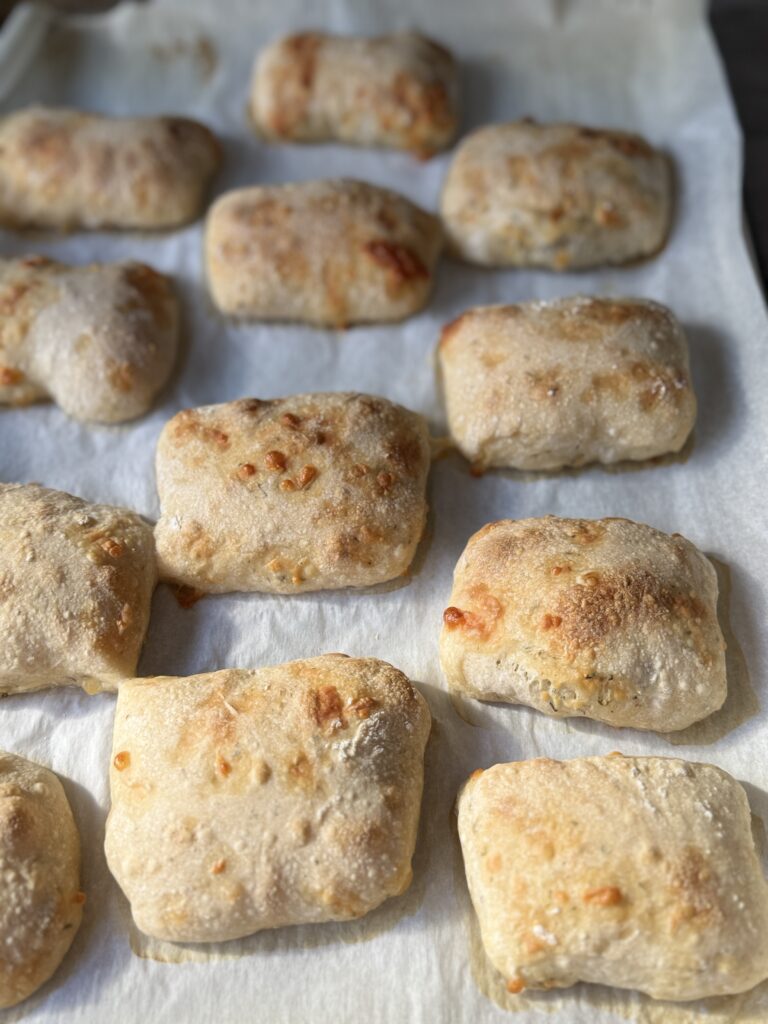
How to make Parmesan herb sourdough ciabatta rolls: step-by-step
Baker’s schedule: feed your sourdough starter the evening before you mix the dough. Mix the dough early in the morning, allow it to rise, place in the fridge overnight to bake for the following day.
Hydration: This recipe can be done with 385 grams of water or up to 400 grams. You may want to start with 385 and then work your way up. Either way, the result will be lovely.
Ingredients
- 100 grams active sourdough starter
- 385-400 grams water
- 500 grams bread flour
- 10 grams salt
- 5 grams olive oil
Inclusions:
- 80 grams finely grated Parmesan cheese
- 1 tablespoon mixed dried herbs (rosemary, thyme, oregano, etc.)
Equipment
- Mixing bowl
- Rectangle proofing container
- Baking sheet
- Parchment paper
- Bench scraper
Instructions
- In a mixing bowl, whisk together the active sourdough starter and water until mostly dissolved.
- Then, add the flour, salt, and olive oil and mix until the flour has absorbed all the water.
- Cover the bowl with plastic wrap and let it rest for 30 minutes.
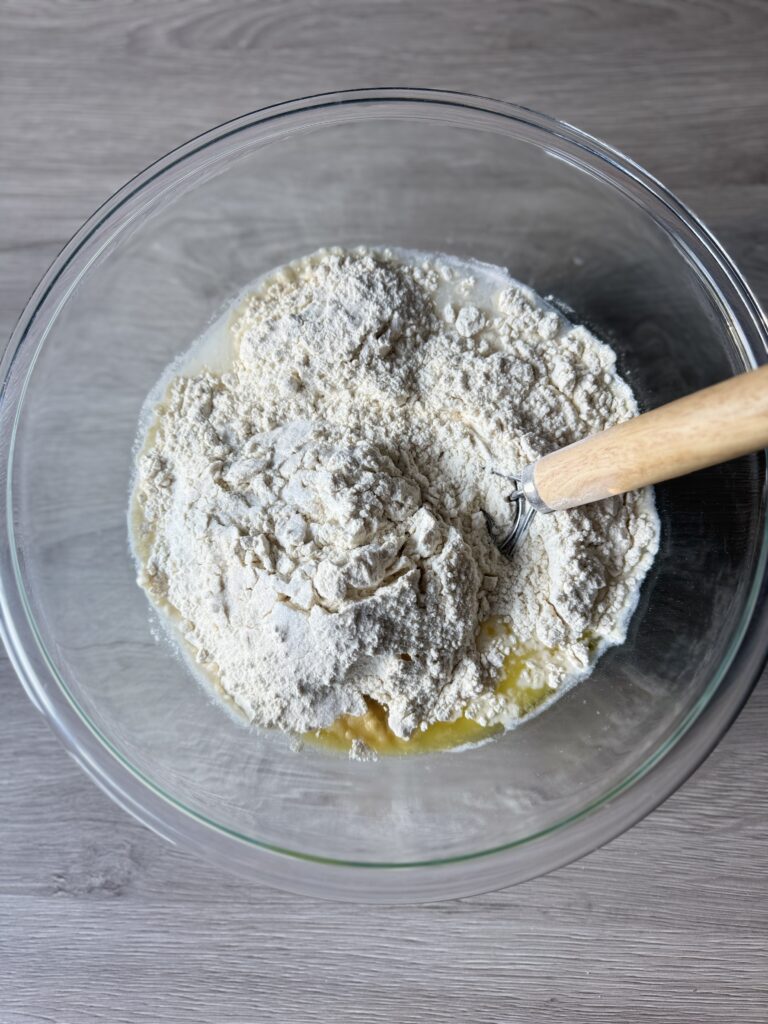
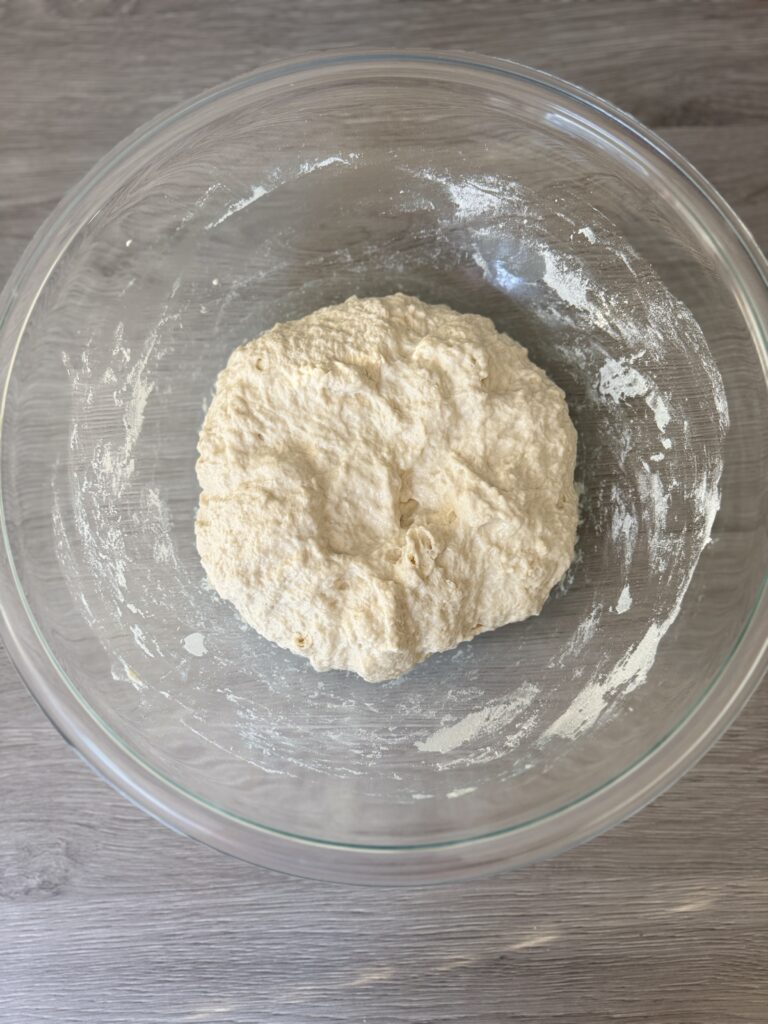
Add the inclusions
- After the dough has rested, sprinkle a little of the Parmesan and herbs over the surface of the dough, then lift and fold one portion of the dough up and over to enclose them.
- Repeat this process, adding a bit more cheese and herbs, then folding the dough over until you’ve finished all of your stretches and folds and used all of the inclusions
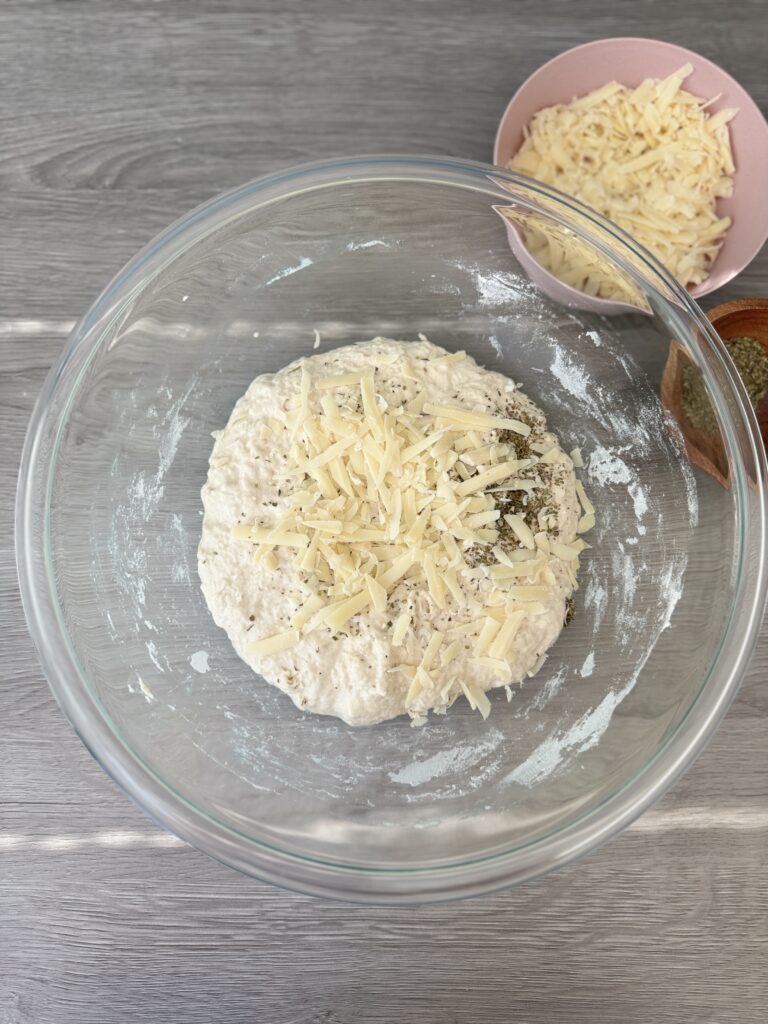

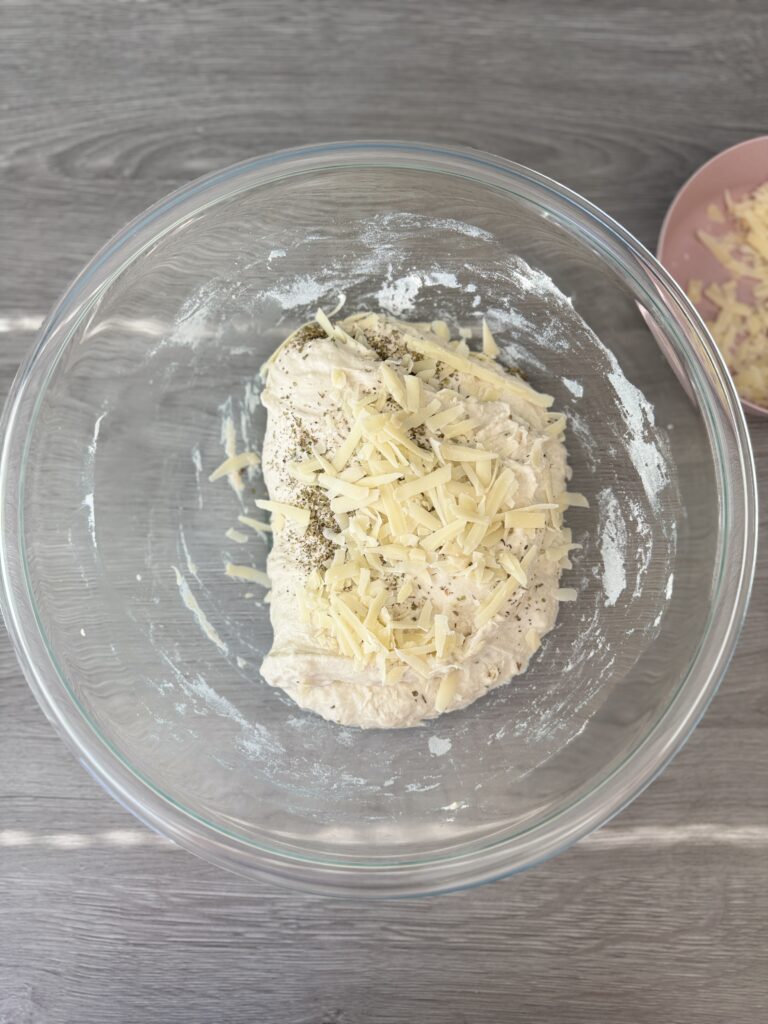
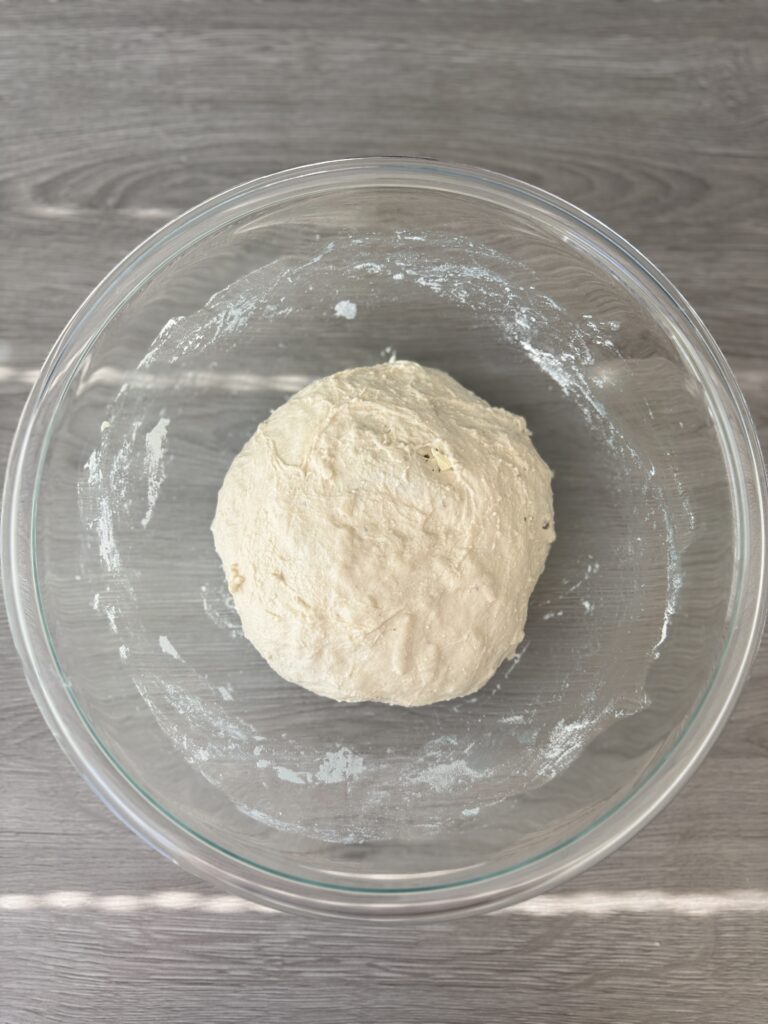
- Once all of the inclusions have been added, cover the dough and let it rest for 30 minutes.
- Continue with 3 more rounds of stretch and folds, spaced about 30 minutes apart. Each time, lightly dampen your hands, gently lift and stretch one side of the dough up, then fold it over itself, rotating the bowl and repeating on all sides until the dough feels tighter and more elastic.
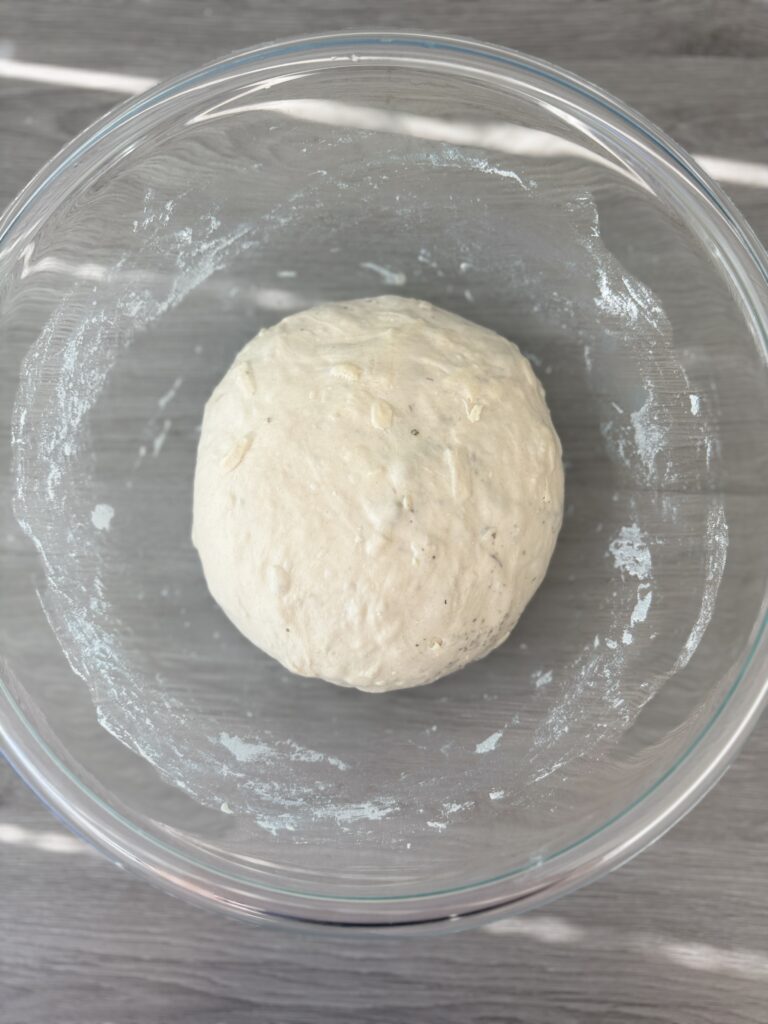
Transfer the ciabatta dough to the proofing container
- After all 4 stretch and folds have been completed, transfer the dough to your rectangular proofing container. Anything around 8.5 cups will work.
- Once the dough has increased in volume by 50-75%, cover it and transfer it to the refrigerator for 8-36 hours.
- For the dough to increase by 50-75%, it can take anywhere from 5-8 hours depending on the temperature in your home. Mine took 6 hours @ 72 degrees F.
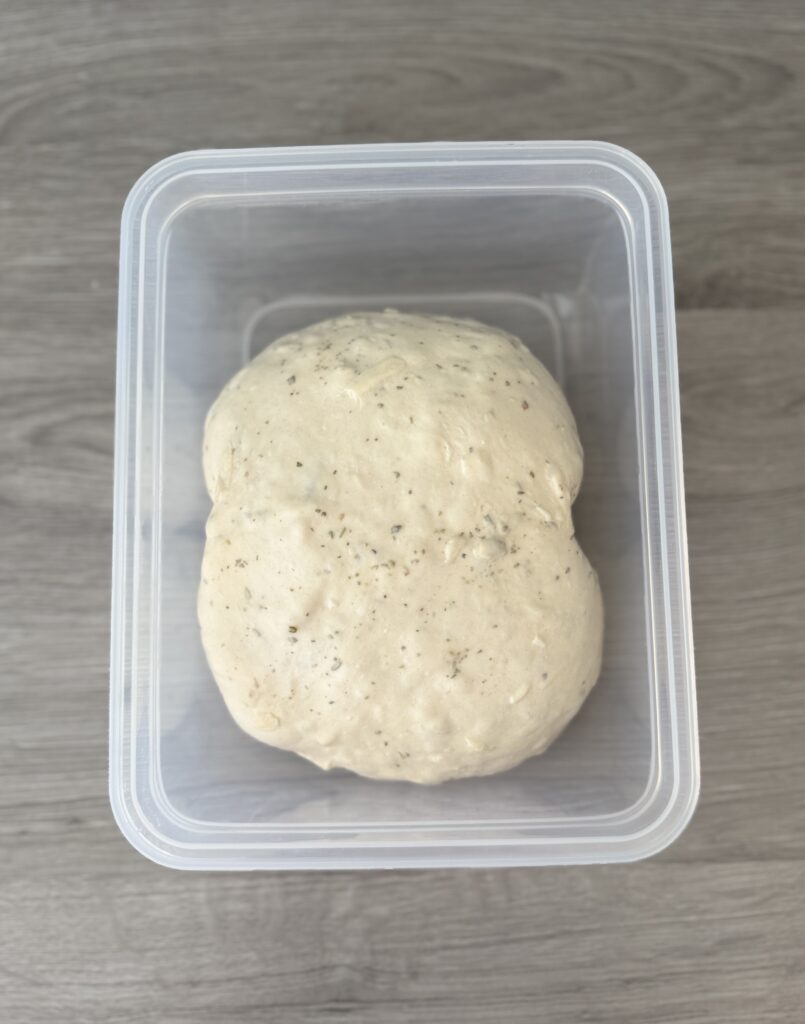
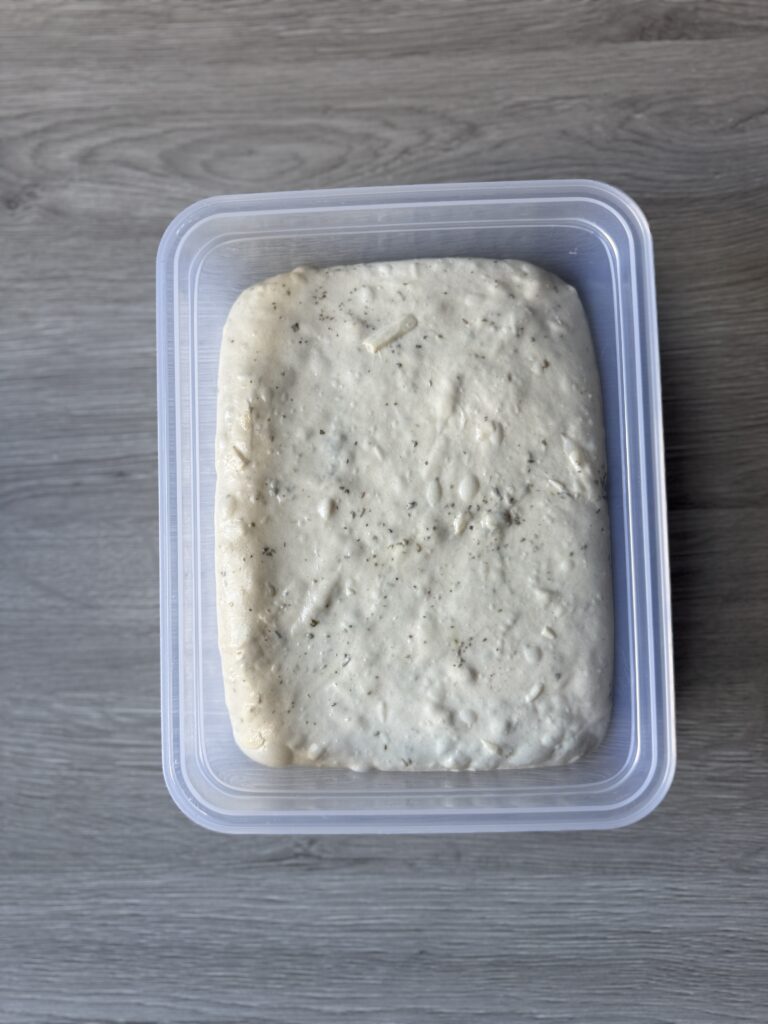

Shape the dough
- The following morning, remove the dough from the refrigerator and line a baking sheet with parchment paper. Additionally, spray a little non-stick oil on the parchment paper.
- Liberally flour your work surface and the top of the dough. It is a sticky dough, so don’t be shy about using enough flour.
- Using a silicone scraper tool or silicone spatula gently loosen the sides of the dough from the container. Then, invert the container onto the work surface and allow the dough to naturally fall out.
- Sprinkle flour over the entire surface of the dough and gently pat the dough into a 15×9 rectangle.
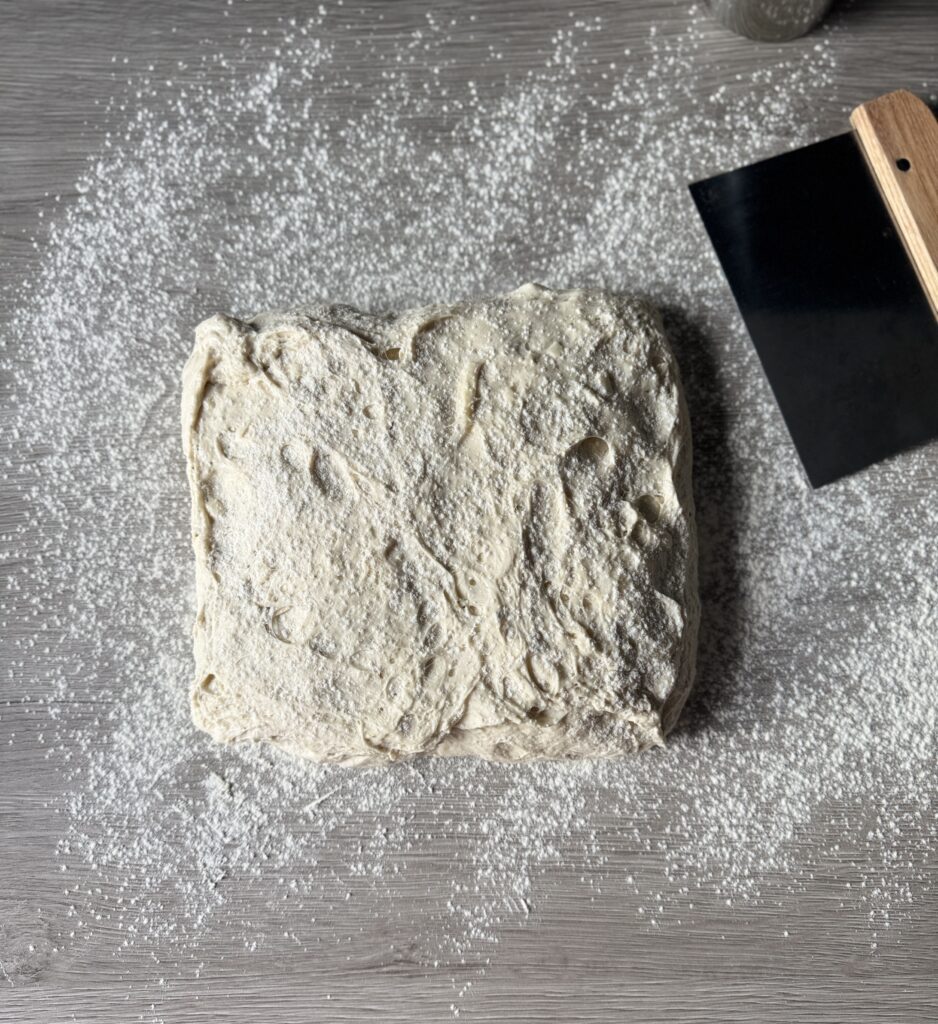
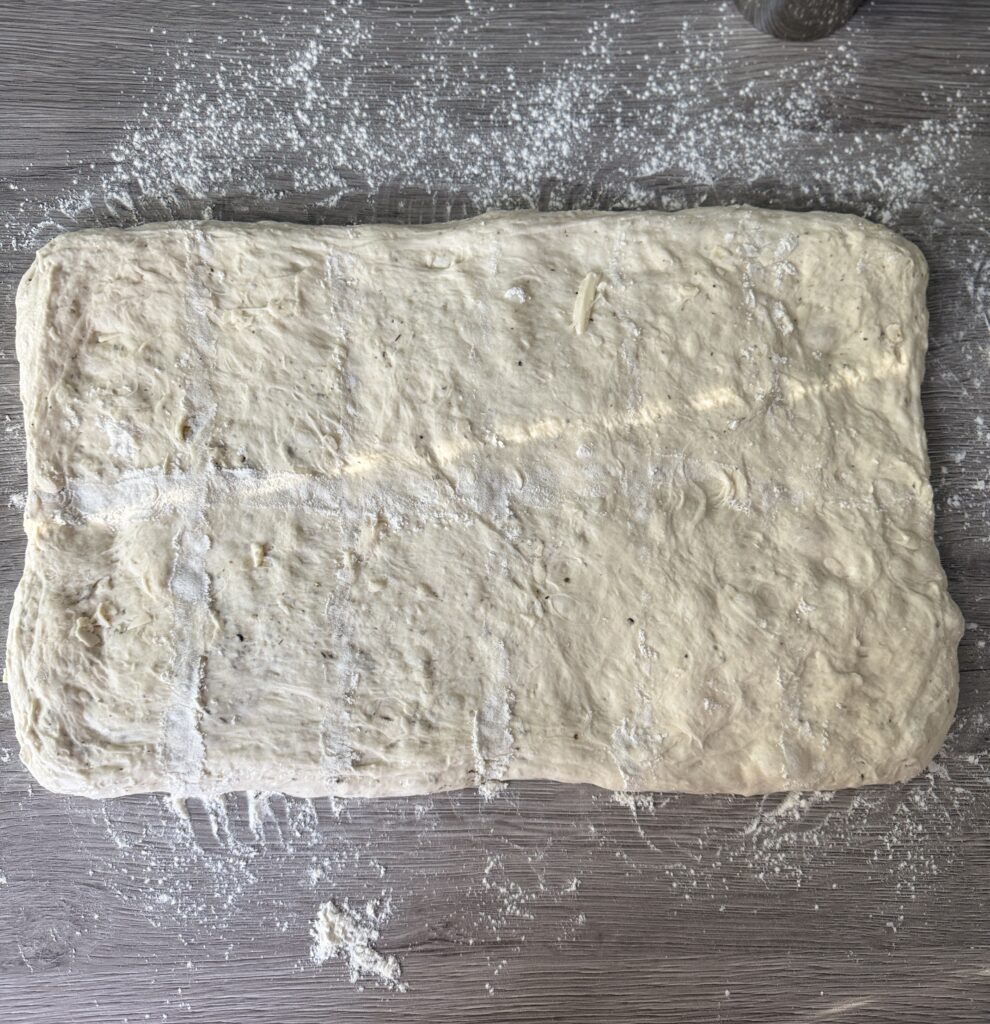
- Then, use a bench scraper to cut the dough into 12 pieces. I like to “mark” the dough first by dusting it lightly with flour and dragging my finger or the scraper to draw guide lines—one down the center, then five evenly spaced lines (about 2.5 inches apart)—so it’s easy to see where to cut.
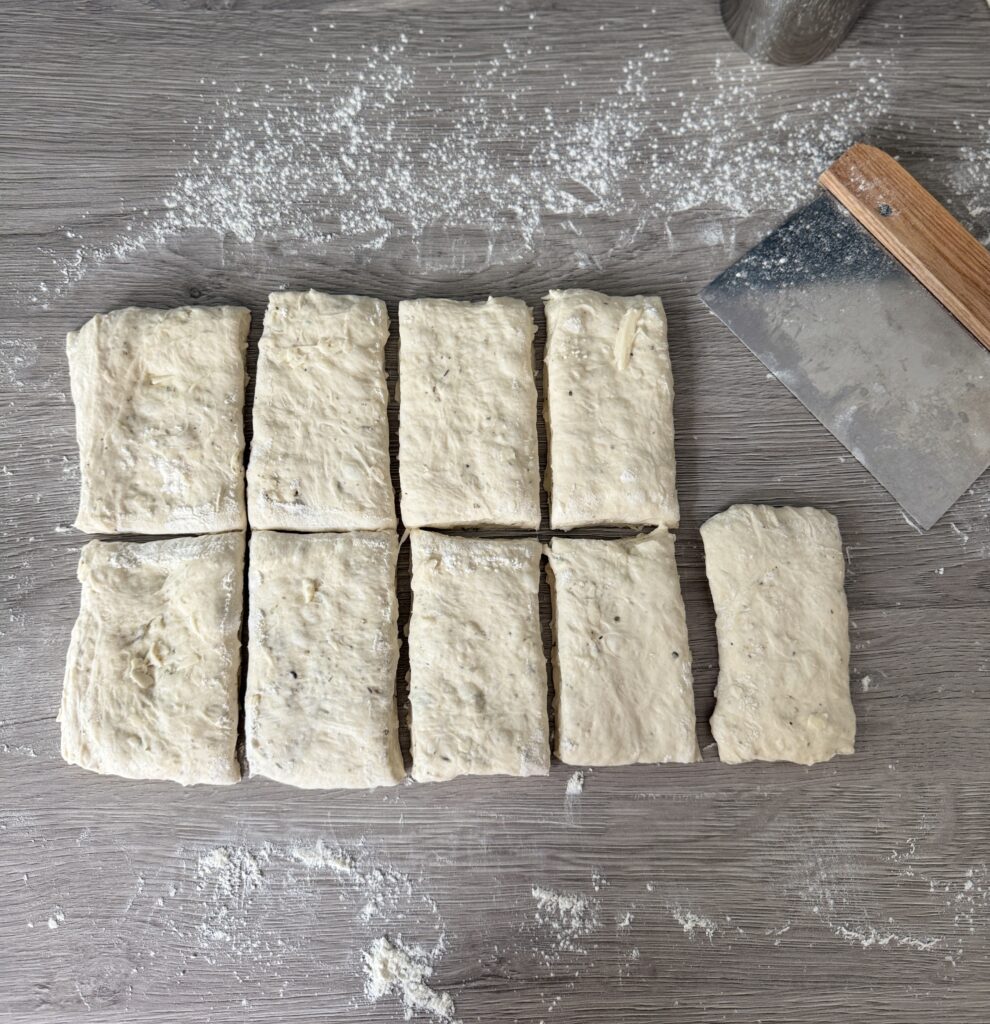

- Place each piece of dough onto the baking sheet about an inch apart, sprinkle with a little flour, & cover with oiled plastic wrap or a large proofing bag and allow it rest for 1-2 hours in a warm spot.
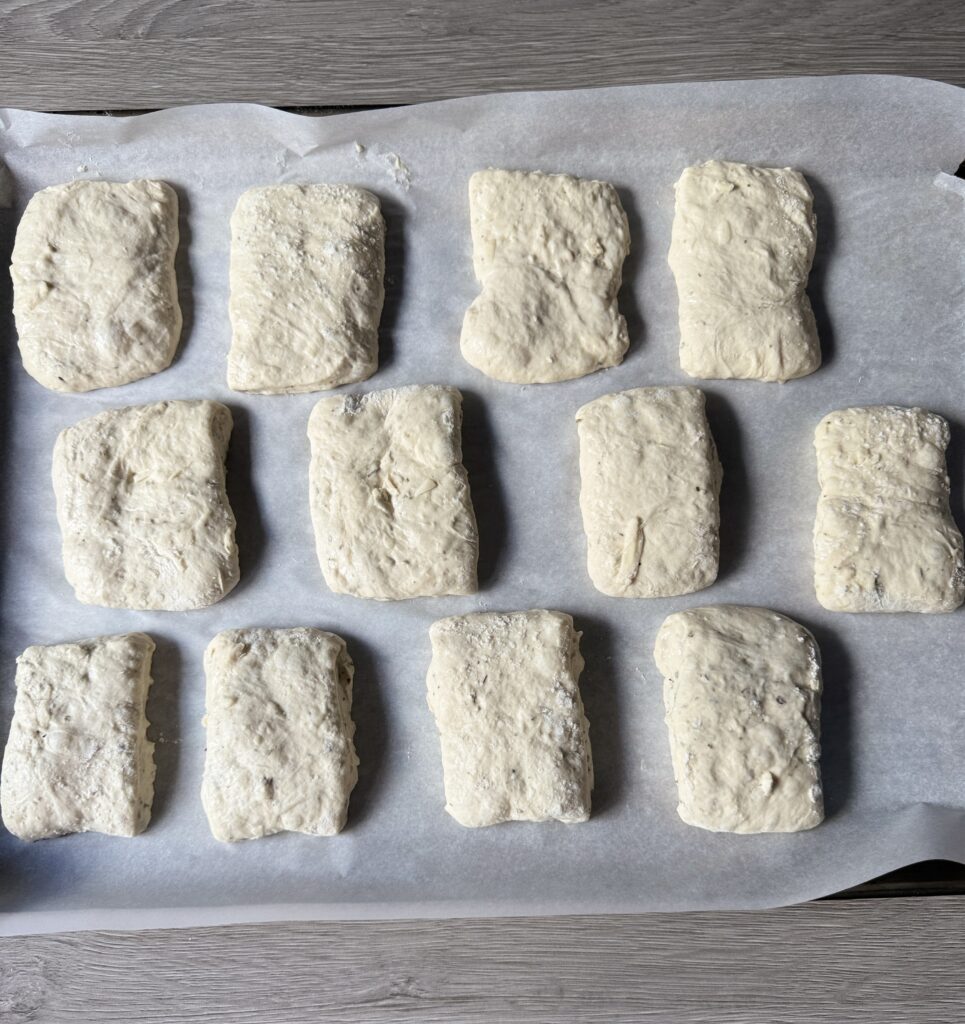

Bake the Parmesan herb sourdough ciabatta rolls
- When ready to bake the rolls, preheat your oven to 475 degrees F and bake for 10 minutes. Reduce the temperature to 450 degrees F and bake for 8-10 minutes more or until the bread starts to brown.
- Remove from the oven and allow the bread to cool for 10-15 minutes and enjoy warm. Parmesan herb sourdough ciabatta rolls are lovely with a garlic herb butter!
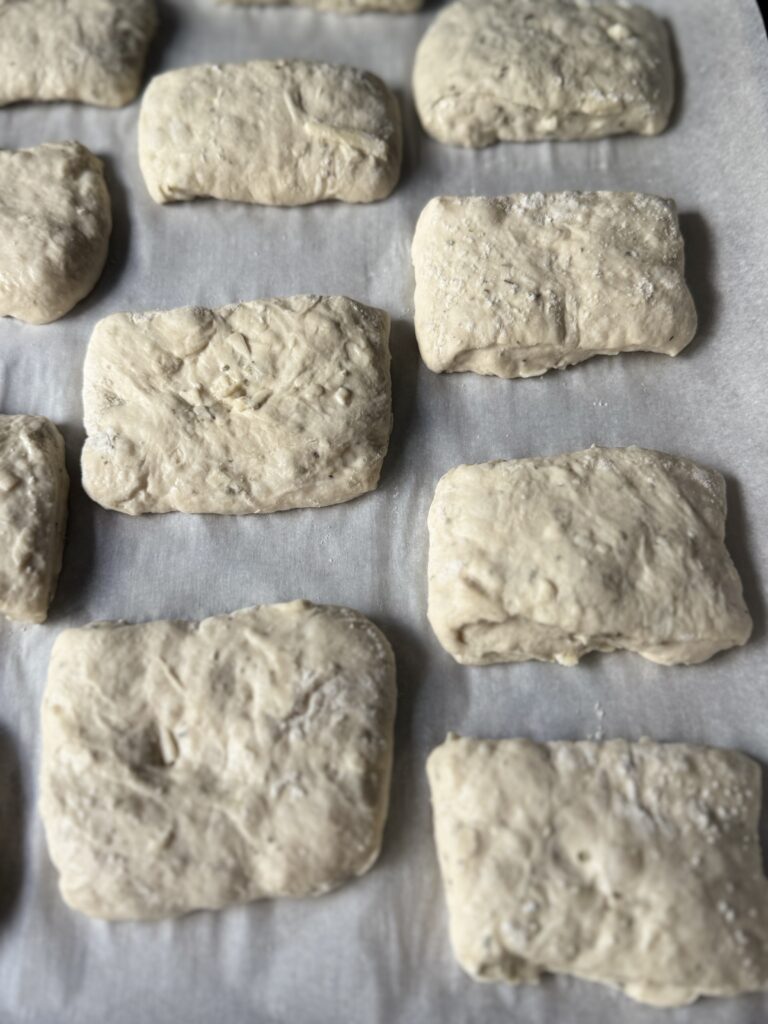

- Any leftover sourdough ciabatta bread can be stored in an airtight container or bread bag for 3-4 days on the counter.

More sourdough recipes like this
- Sourdough Ciabatta Bread
- Cranberry Brie Sourdough Focaccia Muffins
- Easy Sourdough Focaccia Bread
- Soft Sourdough Brioche Dinner Rolls
Parmesan Herb Sourdough Ciabatta Rolls
Equipment
- Mixing bowl
- rectangle proofing container 8.5 cups
- Baking sheet
- Parchment paper
- Bench scraper
Ingredients
- 100 grams active sourdough starter
- 385-400 grams water see notes
- 500 grams bread flour
- 10 grams salt
- 5 grams olive oil
Inclusions
- 80 grams finely grated Parmesan cheese
- 1 tablespoon dried herbs rosemary, thyme, oregano, etc.
Instructions
- In a mixing bowl, whisk together the active sourdough starter and water until mostly dissolved.
- Then, add the flour, salt, and olive oil and mix until the flour has absorbed all the water.
- Cover the bowl with plastic wrap and let it rest for 30 minutes.
Add the inclusions
- After the dough has rested, sprinkle a little of the Parmesan and herbs over the surface of the dough, then lift and fold one portion of the dough up and over to enclose them.
- Repeat this process, adding a bit more cheese and herbs, then folding the dough over until you’ve finished all of your stretches and folds and used all of the inclusions
- Once all of the inclusions have been added, cover the dough and let it rest for 30 minutes.
- Continue with 3 more rounds of stretch and folds, spaced about 30 minutes apart. Each time, lightly dampen your hands, gently lift and stretch one side of the dough up, then fold it over itself, rotating the bowl and repeating on all sides until the dough feels tighter and more elastic.
Transfer the ciabatta dough to the proofing container
- After all 4 stretch and folds have been completed, transfer the dough to your rectangular proofing container. Anything around 8.5 cups will work.
- Once the dough has increased in volume by 50-75%, cover it and transfer it to the refrigerator for 8-36 hours.For the dough to increase by 50-75%, it can take anywhere from 5-8 hours depending on the temperature in your home. Mine took 6 hours @ 72 degrees F.
Shape the dough
- The following morning, remove the dough from the refrigerator and line a baking sheet with parchment paper. Additionally, spray a little non-stick oil on the parchment paper.
- Liberally flour your work surface and the top of the dough. It is a sticky dough, so don't be shy about using enough flour.
- Using a silicone scraper tool or silicone spatula gently loosen the sides of the dough from the container. Then, invert the container onto the work surface and allow the dough to naturally fall out.
- Sprinkle flour over the entire surface of the dough and gently pat the dough into a 15×9 rectangle.
- Then, use a bench scraper to cut the dough into 12 pieces. I like to “mark” the dough first by dusting it lightly with flour and dragging my finger or the scraper to draw guide lines—one down the center, then five evenly spaced lines (about 2.5 inches apart)—so it’s easy to see where to cut.
- Place each piece of dough onto the baking sheet about an inch apart, sprinkle with a little flour, & cover with oiled plastic wrap or a large proofing bag and allow it rest for 1-2 hours in a warm spot.
Bake the Parmesan herb sourdough ciabatta rolls
- When ready to bake the rolls, preheat your oven to 475 degrees F and bake for 10 minutes. Reduce the temperature to 450 degrees F and bake for 8-10 minutes more or until the bread starts to brown.
- Remove from the oven and allow the bread to cool for 10-15 minutes and enjoy warm. Parmesan herb sourdough ciabatta rolls are lovely with a garlic herb butter!
- Any leftover sourdough ciabatta rolls can be stored in an airtight container or bread bag for 3-4 days on the counter.


Leave a Comment & Rate the Recipe